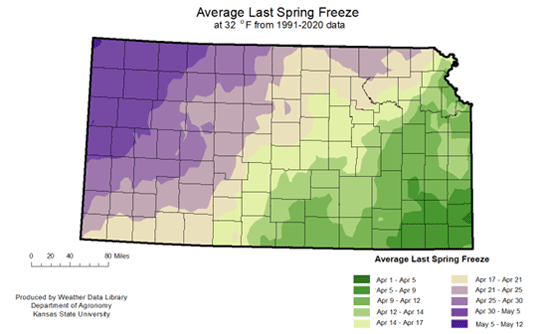The planting date is one of the most critical factors for row crops. Farmers should consider basing this decision on soil temperature and moisture rather than just calendar dates.
Soil temperatures
After a cooling trend during the second week of March, air temperatures across Kansas seem to be back to normal again, but the forecast indicates we may fall below normal in the coming days. Therefore, planting decisions should consider the current soil temperatures and the short-term (7-day period) forecast.
For the 7-day period between March 15 and 21, average soil temperatures at 2 inches across Kansas districts ranged from 43oF to 44oF (Figure 1). You can monitor soil temperatures across the state by using the Kansas Mesonet’s soil temperature tracking tool at https://mesonet.k-state.edu/agriculture/soiltemp/.

Figure 1. Average soil temperatures at 2-inch soil depth for the week of March 15 to 21, 2024. Source: Kansas Mesonet. (https://mesonet.k-state.edu/agriculture/soiltemp/)
Projections for the next 6-10 days lean toward below-normal temperatures statewide (Figure 2). In parallel, there is a slight favor for above-normal precipitation in the northwest, with the remainder of the state having equal chances of at/below/above normal moisture, which may contribute to maintaining cool soil temperatures (Figure 3).
It is worth mentioning that topsoil temperature differences could be large depending on multiple factors. Actual changes in any given field will be affected by several factors, including soil type, soil moisture, residue cover, tillage, landscape position, and others. For example, wet soils under a no-tillage system are expected to warm up slower. Dry soils will fluctuate more rapidly, matching air temperatures, particularly if skies are clear.

Figure 2. 6 to10-day temperature outlook for March 26-30, 2024. Source: NOAA.

Figure 3. 6 to10-day precipitation outlook for March 26-30,2024. Source: NOAA.
Soil moisture
Current soil moisture is lowest across portions of southwest and south-central Kansas (Figure 4). Recent precipitation has improved moisture in the north and eastern parts of the state over the last week. However, actively growing vegetation has increased demands in these areas as well.

Figure 4. Soil moisture as percent of saturation at 2 inches (5 cm) as of March 21, 2024. Source: Kansas Mesonet https://mesonet.k-state.edu/agriculture/soilmoist/
The largest departure in precipitation occurred in south-central Kansas over the last two weeks (Figure 5). No substantial change in moisture is expected in this region, and March is likely to end on the dry side for much of southwest and south-central Kansas (Figure 3).

Figure 5. Departure from normal precipitation for the last two weeks ending March 21, 2024. Shades of orange indicate below normal precipitation. Source: Kansas Mesonet.
Management considerations
Optimal soil temperature for crop emergence
Every summer row crop has an optimal soil temperature for its emergence. Corn's minimum temperature for germination and early growth is 50°F. When soil temperatures remain at or below 50 degrees after planting, the damage to germinating seeds can be particularly severe.
Uniformity and synchrony in emergence are critical and primarily achieved when soil temperatures are consistently above 55oF. Uneven soil temperatures around the seed zone can produce non-uniform crop germination and emergence. Lack of uniformity in emergence can greatly impact corn potential yields. Competition between early-emerged and late-emerged plants, as well as competition from weeds, may negatively impact biomass and grain production. Compensation mechanisms like tillering have limited potential compared to other crops' compensation mechanisms, like branching in soybeans.
Impact of a hard freeze on corn
Corn is also more likely than other summer crops to be affected by a hard freeze after emergence if it is planted too early. The impact of a hard freeze on emerged corn will vary depending on how low the temperature gets, the intensity and duration of the low temperatures, field variability, residue distribution, tillage systems, soil type, moisture conditions (more severe under dry conditions), and the growth stage of the plant. Injury is most likely on young seedlings or plants beyond the V5-6 growth stage when the growing point is above the soil surface.
The average day for last spring freeze (32oF) varies considerably across the state (Figure 6). From southeast to northwest Kansas; the earliest last spring freeze date is April 1-14 and latest is May 5-12. Thus, corn planting dates before the second week of April in the southeast or the second week of May in the northwest would represent a high risk of suffering from a late spring frost damage.

Figure 6. Average last spring freeze (32 degrees F) for Kansas. Source: Kansas Mesonet.
More information about the planting status of summer row crops will be provided in upcoming issues of the Agronomy eUpdate. Stay tuned!
Ignacio Ciampitti, Farming Systems
ciampitti@ksu.edu
Christopher “Chip” Redmond, Kansas Mesonet Network Manager
christopherredomond@ksu.edu
Tags: soil moisture spring planting planting soil temperature